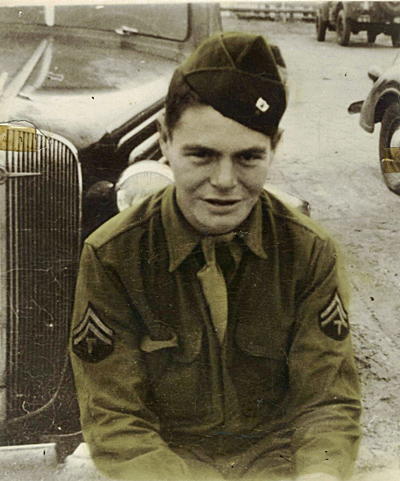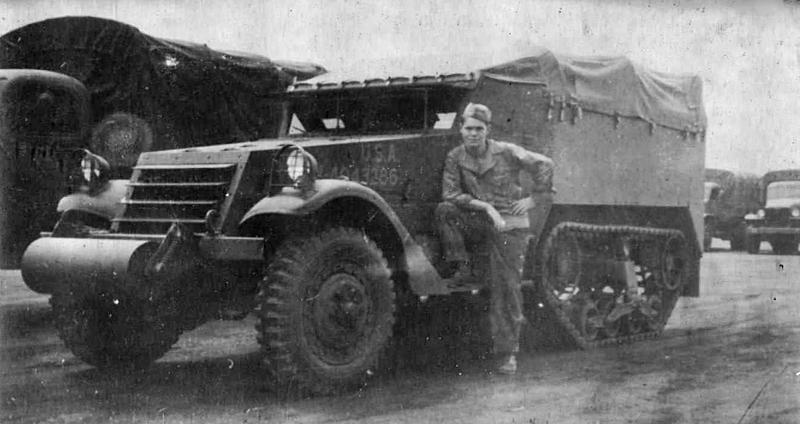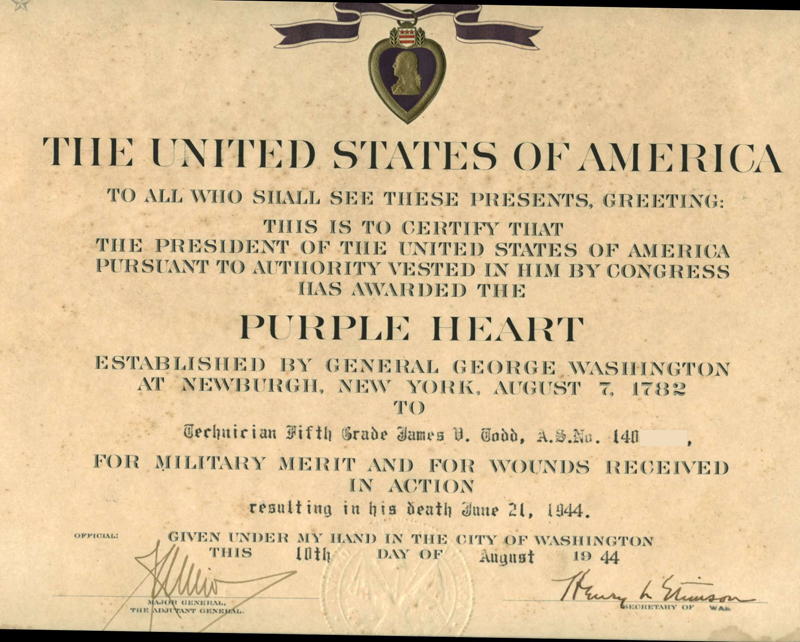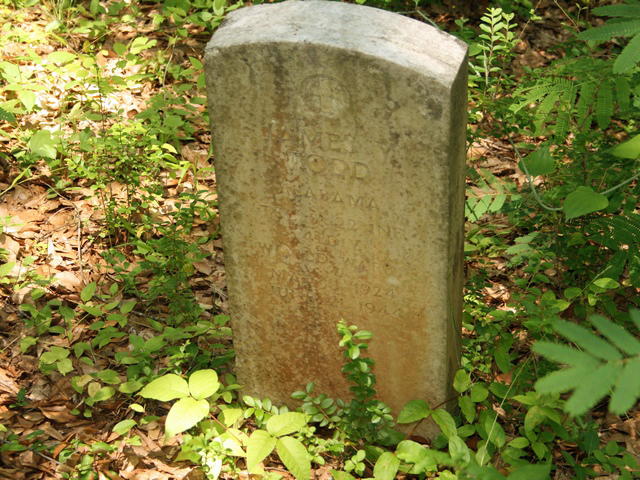

James V. Todd
Headquarters Company 1st Battalion 22nd Infantry
4th Infantry Division
KIA 06/21/1944
James Vernon Todd was born in
Slyacauga, Talladega County, Alabama on May 11, 1924.
(His enlistment record lists his birth year as 1922.)
He enlisted in the Regular Army
on November 15, 1940 at Fort McClellan, Alabama. His home of
residence was listed as Sylacauga, Talledega County, Alabama and
his civilian occupation was listed
as Actors and actresses. He had completed one year of High School
and was single with no dependents.
His religion was listed as Protestant.
He was awarded the Good Conduct
Medal in Headquarters 22nd Infantry
General Orders No. 14 dated December 31, 1943 at Fort Jackson,
South Carolina.
Technician 5th Grade Todd was
killed in action in France, near the town of
LeThiel, during the attack towards Cherbourg on June 21, 1944.
HE GAVE HIS ALL: VERNON TODD IN WORLD WAR II
Vernon Todd was born May 11,
1924. He was the oldest of eight children. His parents were
workers at the Avondale Mills
in Sylacauga, AL. Times were hard then and it would have been
easy for Vernon to give up and quit trying. Instead he
pushed himself harder and harder. He attended school at B.B.
Comer Memorial School, and during the ten years he attended grade
and high school he never missed a day--nor was he late a single
time. He made excellent grades and had many friends.
He was engaged to be married to a girl named Eloise Carver when
he enlisted.
Vernon enlisted on November 15,
1941[sic]. This was before Pearl Harbor had been bombed and
America was even in the war.
He began training at Fort McClellan, AL. From there, he went to
Fort Benning, GA, then to Camp Gordon, GA. By 1943,
he was stationed at Fort Dix, NJ. In September of that year,
Vernon's regiment, the Twenty-second Infantry, celebrated
its seventy-seventh birthday. They had a big beer party and it
was a holiday for the regiment. He also got to see an exhibition
by Joe Louis, the boxer, that month.
On September 27, 1943, he was at
Camp Gordon-Johnson, near Appalachicola, FL. He was taking
amphibious training
in preparation for what came to be known as D-Day. Camp
Gordon-Johnson was not an especially wonderful place to be.
It was on the Gulf of Mexico and the huts they lived in had sand
floors. They usually had scorpions, tarantulas and coral snakes
in them. The usual "enemy" beach was Dog Island. They
landed on it time and time again. They marched four miles in
forty-five minutes and sixteen miles in eight hours. They were
too tired to do anything else but sleep. The camp
was also known as Camp Carrabelle and some of the soldiers made
up a poem about it:
The Devil in Hell, we're told,
was chained
And a thousand years he there remained
He neither complained, nor did he groan,
But determined to start a Hell of his own...
He scattered some chiggers along
the road
Lizards in the grass, an occasional toad,
The Gulf has sharks, barracuda, stingrays,
And, in the sand, he mixed millions of fleas.
To the tail of the jellyfish, he
added a sting,
Then the dragonfly, he put on the wing.
He added some typhoid to all of the drink
With a pinch of sulphur, to make it stink.
The rattlesnake bites you, the
horsefly stings,
The mosquito delights you with buzzing wings
Sandburrs cause you to jig and to dance,
And those who sit down get ants in the pants...
The heat in the summer is one
hundred and ten,
Too hot for the Devil, too hot for the men.
Come see for yourself and you can tell
It's a helluva place this Camp Carrabelle.
Early in December of 1943,
Vernon was transferred to Fort Jackson, SC. He was supposed to
come home that Christmas
and marry his sweetheart, Eloise. Instead, they sent him to Fort
Jackson in preparation for going overseas. They had a good meal
that Christmas, with turkey and dressing and all the trimmings.
Vernon sent home a menu they had printed up. On the back,
the names of the soldiers were listed. Vernon was listed as a
Technician Fifth Grade in the Headquarter's Company, First
Battalion,
Twenty-second Infantry, Fourth Division.
Vernon sailed from New York for
England in early January 1944. There, he spent most of his time
practicing for D-Day.
The Fourth Division took part in Operation Tiger on April 28.
This was the final training exercise. General Roosevelt had been
assigned as assistant division commander. The exercise started
out as planned. Things began to go wrong, though, because
somehow two elements of German E Boats had crossed the English
Channel and gotten in among the LST convoy
that was bringing engineers, tanks and other vehicles to
participate in the landing.
All the brass had come to watch
this exercise since it was the last one. Generals Eisenhower and
Montgomery were there,
along with General J. Lawton Collins, commander of the VII Corps,
and several others. They could not understand what had
gone wrong. Later that day they found out that the E-boat attack
had caused about 800 casualties. For a while they were worried
that the Germans might have captured some soldiers and forced
them to tell about the plans for D-Day, but all the bodies
were finally accounted for.
On D-Day, the Fourth Division
landed on Utah Beach. First ashore was the Eighth Infantry, then
Vernon's regiment,
the Twenty-second Infantry. The reserve was the Twelfth Regiment.
There was no opposition from the Germans on shore.
About an hour and a half after the Eighth Infantry had moved
inland, the Twenty-second Infantry landed. They headed inland
across the marshes toward St. Martin-de-Varreville and St.
Germain-de-Varreville.
Just before the middle of June,
General Bradley ordered the Fourth and Ninetieth Division to move
abreast toward Cherbourg,
an important port. Vernon's last letter home was dated June 15,
1944. He couldn't tell what had been happening but he did say
he was in action and that it was nothing like maneuvers. He had
not killed any Germans yet and hoped that he didn't have to.
They were really living in the rough and some days they didn't
even get a chance to wash their hands. He told his mother
not to worry about him because he was fairly safe and things
weren't too bad. That was the last they heard from him.
He was declared missing in
action and it was not until February of 1945 that they learned of
his death. It was April of that year
before they learned any of the details surrounding his death. A
chaplain, 1st Lt. Gerald J. Rabe, sent two letters about Vernon.
They said that Vernon was a half track driver in the Anti-Tank
platoon of his company. On June 21, 1944, the First Battalion
was moving up the Cherbourg peninsula, in the vicinity of
LeThiel, France. Enemy artillery fire, especially from coastal
guns
had been intense and shrapnel from one of the shells killed
Vernon instantly as he took shelter near his vehicle.
He was buried at St. Mere Eglise No. 2, United States Military
Cemetery, in Normandy France. Part of the letter reads:
...as a soldier, your boy
bravely fought and bravely died, to stamp out the threat of
slavery which hangs over the world today.
As a member of our great Allied Armies, he brought liberation,
new hope, and new life to nations that had been insulted,
robbed, tortured, defiled, and enslaved by their conquerors. With
such courage and strength in his heart, he walked humbly
with his God, and was therefore worthy to conquer.
Vernon was awarded the Purple
Heart for wounds received in action, resulting in his death. His
parents also received a certificate
signed by Franklin Roosevelt. It reads:
In grateful memory of Technician
Fifth Grade James V. Todd, who died in the service of his country
in the European Area,
June 21, 1944. He stands in the unbroken line of patriots who
have dared to die that freedom might live and grow and
increase its blessings. Freedom lives, and through it, he
lives--in a way that humbles the undertakings of most men.
From the webpage: Family Stories

Vernon Todd and his halftrack
From the webpage: Family Stories

Certificate for the award of the Purple Heart Medal to T5 James V. Todd
From the webpage: Family Stories
James V. Todd was buried in the
temporary U.S. Military Cemetery
Sainte Mere-Eglise #2 at Carentan, France and later his remains
were returned to the
United States where he was interred in Alabama in September 1948.
Burial:
Comers Cemetery
Sylacauga
Talladega County
Alabama

Grave marker for James V. Todd
The inscription reads:
TEC 5 22 Inf. 4 Div. WWII
Photo by Chuck Jones from the Find a Grave website
Home | Photos | Battles & History | Current |
Rosters & Reports | Medal of Honor | Killed
in Action |
Personnel Locator | Commanders | Station
List | Campaigns |
Honors | Insignia & Memorabilia | 4-42
Artillery | Taps |
What's New | Editorial | Links |